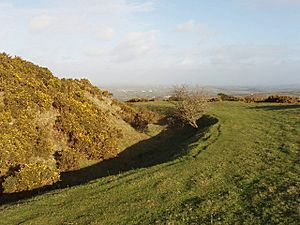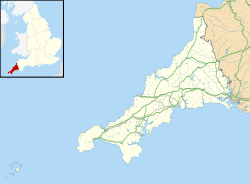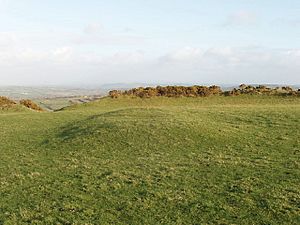Warbstow Bury facts for kids

Rampart and ditch at the south of the fort
|
|
| Location | Near Warbstow, Cornwall |
|---|---|
| Coordinates | 50°41′22″N 4°32′51″W / 50.68944°N 4.54750°W |
| Type | Hillfort |
| Area | 7.5 hectares (19 acres) |
| History | |
| Periods | Iron Age |
| Designated | 26 November 1928 |
| Reference no. | 1006710 |
Warbstow Bury is an ancient hillfort from the Iron Age. It's located about 0.5 miles (0.8 km) west of Warbstow village in Cornwall, England. This special place is protected as a scheduled monument.
Contents
Exploring Warbstow Bury Hillfort
This historic site sits 807 feet (246 meters) above sea level. It is on a hill where two small rivers begin. From here, you can see far away to Lundy Island and Dartmoor.
What Does the Hillfort Look Like?
Warbstow Bury is one of the biggest earthworks in Cornwall. It is shaped like a large oval. The whole area covers about 7.5 hectares (18.5 acres).
The fort has two round walls and ditches. These are built one inside the other. The walls, called ramparts, are up to 5.8 meters (19 feet) high. The ditches are up to 2.7 meters (9 feet) deep. In the southern part, you can still see parts of an even older wall.
Entrances to the Fort
The inner wall has two original entrances. They face each other, one in the northwest and one in the southeast. These entrances are curved inwards. The outer wall also has simple entrances that line up with the inner ones.
The Giant's Grave: A Medieval Mystery
In the middle of the hillfort, there is a rectangular mound. This mound is from the Middle Ages. It was used as a rabbit warren, a place where rabbits were raised.
This mound is about 22 meters (72 feet) long. It is 10 meters (33 feet) wide and 0.6 meters (2 feet) high. People sometimes call it "The Giant's Grave" or "King Arthur's Grave."



